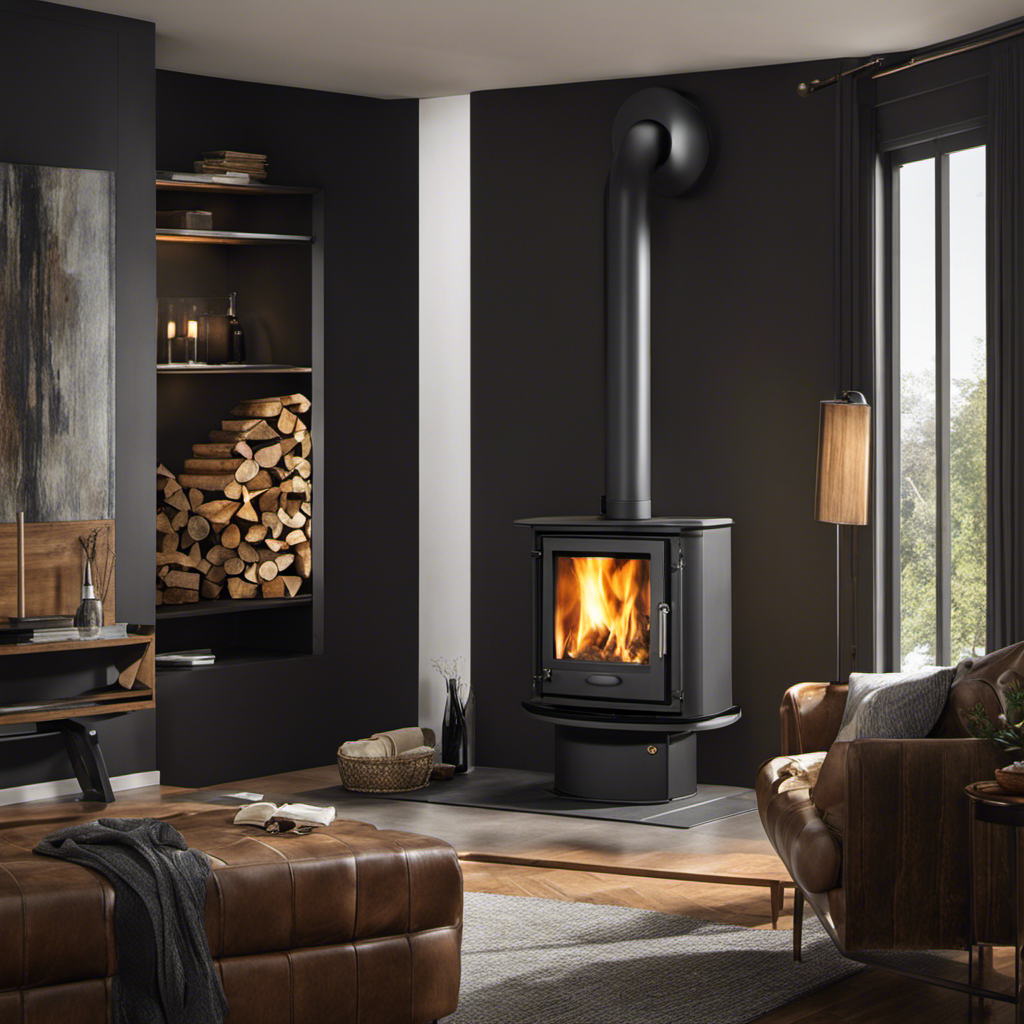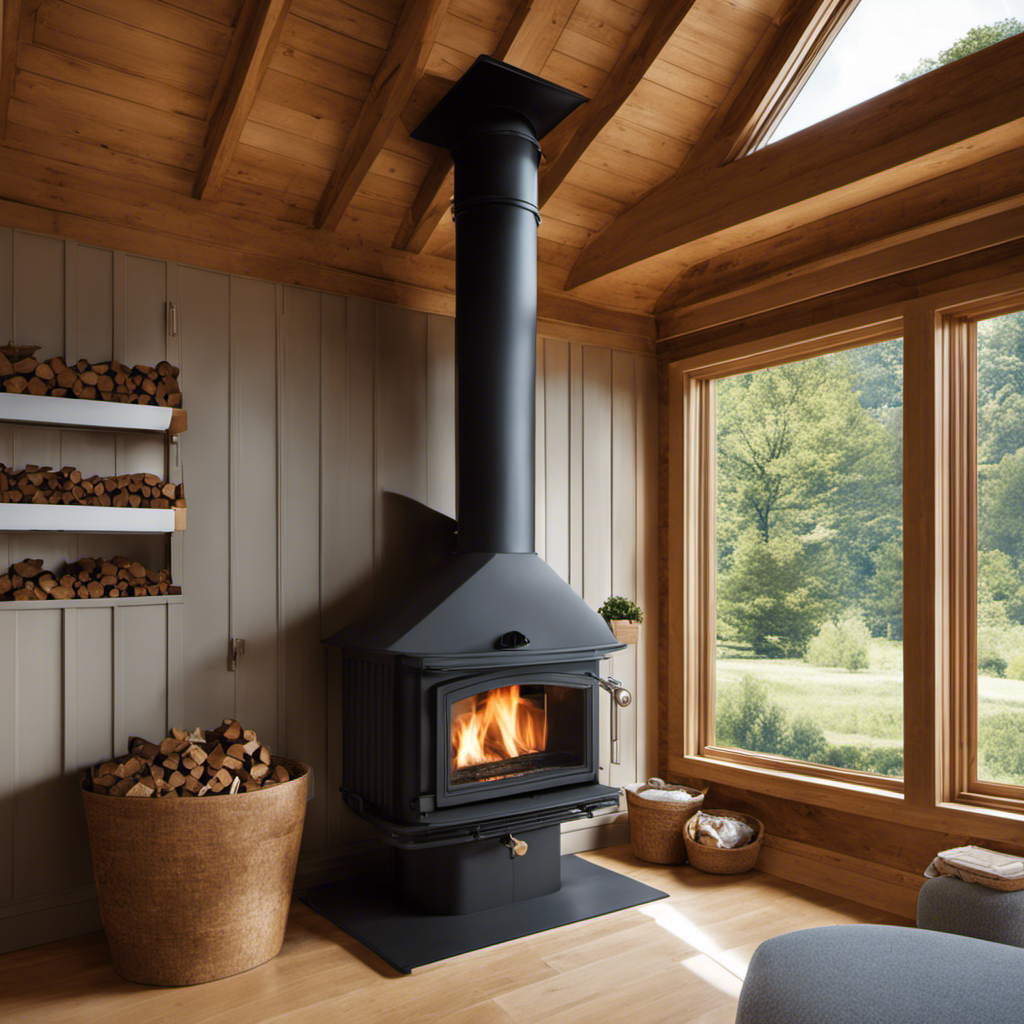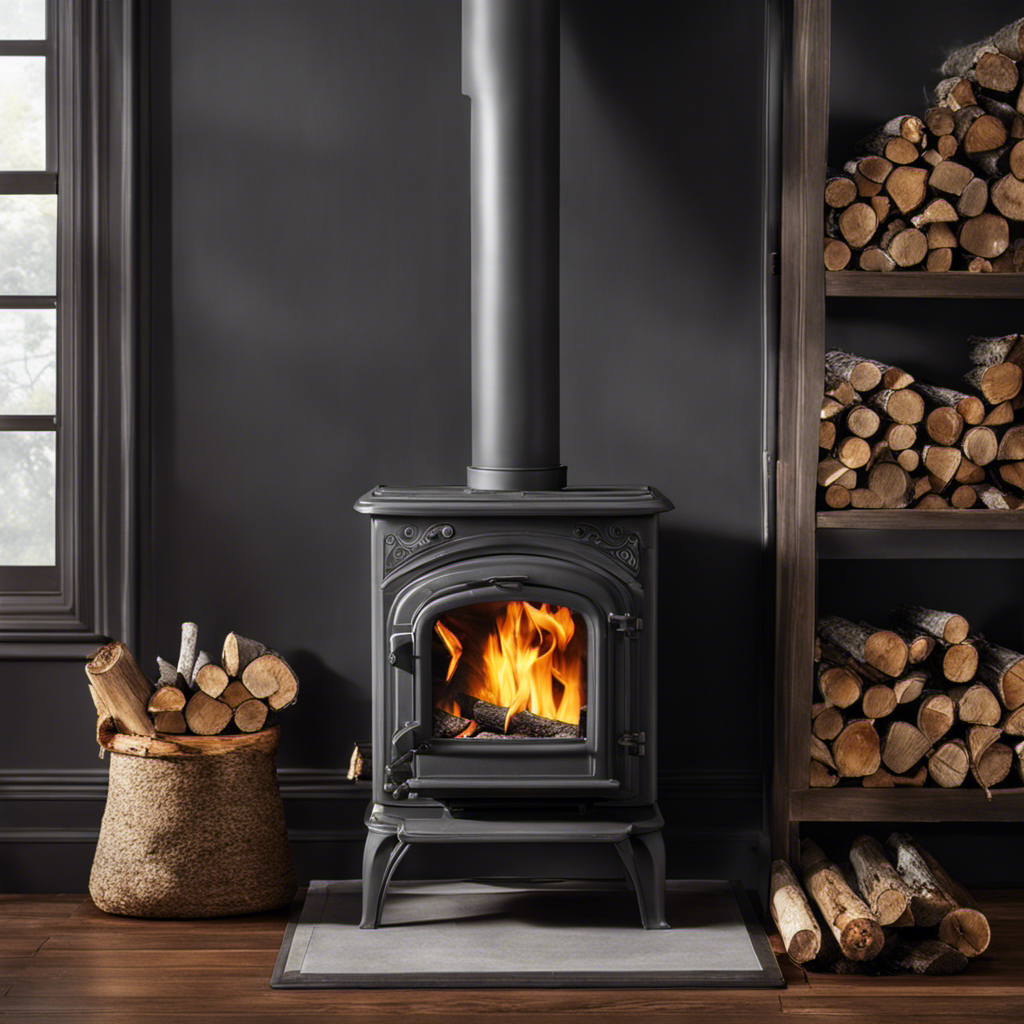Selecting the correct size for your wood stove’s flue pipe involves taking into account several important factors.
In this article, I will explain the importance of selecting the correct size and provide guidance on how to measure your wood stove for a flue pipe.
Additionally, I will offer some tips for properly installing the flue pipe to ensure optimal performance and safety.
Let’s dive into the world of flue pipe sizes for wood stoves.
Key Takeaways
- Flue pipe size is crucial for wood stove functioning and heat transfer efficiency.
- Chimney height, flue pipe material, and wood stove size and output should be considered when choosing a flue pipe size.
- The most common flue pipe sizes for wood stoves are 6 inches and 8 inches.
- Proper installation includes measuring the diameter and height of the flue collar, using high-quality materials, and securing the flue pipe properly.
Understanding Flue Pipe Sizes
I need to research and understand flue pipe sizes so that I can choose the right one for my wood stove. The size of the flue pipe is crucial for the proper functioning of the wood stove and ensuring efficient heat transfer.
One important aspect to consider is the importance of proper flue pipe insulation. Insulation helps to minimize heat loss and maximize the efficiency of the wood stove by maintaining higher temperatures within the flue pipe. It also prevents the formation of condensation, which can lead to corrosion and damage to the flue pipe.
Additionally, understanding the different types of flue pipe materials and their advantages is essential. Common materials include stainless steel, cast iron, and aluminum. Each material has its own benefits, such as durability, corrosion resistance, and heat retention.
Factors to Consider When Choosing a Flue Pipe Size
One important factor to consider when choosing a flue pipe size is the diameter, as it directly affects the efficiency and performance of the wood stove. Selecting the right flue pipe size ensures proper airflow and minimizes the risk of smoke backdraft or insufficient draft.
Here are three key considerations to keep in mind when determining the size of your flue pipe:
-
Chimney height: The height of your chimney plays a crucial role in determining the flue pipe size. A taller chimney creates a stronger draft, allowing for a smaller flue pipe diameter. Conversely, a shorter chimney requires a larger flue pipe to compensate for the weaker draft.
-
Flue pipe material: The material of the flue pipe can also impact its size. Different materials have different thermal properties, affecting the rate at which heat is transferred. Stainless steel flue pipes, for example, have a lower thermal conductivity than galvanized steel, which may require a larger diameter to accommodate for the slower heat transfer.
-
Wood stove size and output: The size and output of your wood stove should also be taken into account when selecting the flue pipe size. Larger stoves with higher heat output may require a larger flue pipe to handle the increased volume of smoke and gases produced.
Common Flue Pipe Sizes for Wood Stoves
The most common flue pipe sizes for wood stoves are 6 inches and 8 inches, providing options for different stove sizes and chimney drafts. Standard flue pipe dimensions are important to consider when installing a wood stove, as they ensure proper airflow and efficient operation.
It’s crucial to choose the correct flue pipe size for your specific wood stove model, as recommended by the manufacturer. Using the wrong size can lead to poor performance, increased creosote buildup, and even potential safety hazards.
To determine the recommended flue pipe size for your wood stove, consult the manufacturer’s specifications or consult with a professional chimney sweep or wood stove installer. They’ll take into account factors such as the stove’s BTU output, the height and diameter of the chimney, and any specific requirements for your local building codes.
Proper sizing of the flue pipe is essential for optimal wood stove performance and safety.
How to Measure Your Wood Stove for a Flue Pipe
Measuring your wood stove accurately is crucial for selecting the right flue pipe size, ensuring optimal performance and safety. To measure your wood stove for a flue pipe, follow these steps:
-
Measure the diameter of the flue collar: Use a tape measure to determine the inner diameter of the flue collar on top of your wood stove. This measurement will determine the size of the flue pipe needed.
-
Measure the height of the flue collar: Measure the distance from the top of the flue collar to the ceiling. This measurement will help determine the length of the flue pipe required.
-
Gather the necessary materials: You’ll need a tape measure, a ladder (if your stove isn’t easily accessible), and a notepad to record your measurements.
By accurately measuring your wood stove, you can ensure that the flue pipe you select fits properly and functions efficiently.
Now, let’s move on to some tips for properly installing a flue pipe for your wood stove.
Tips for Properly Installing a Flue Pipe for Your Wood Stove
After you have measured your wood stove and selected the appropriate flue pipe size, it is important to follow these tips for properly installing it. Proper maintenance and safety precautions are crucial when it comes to wood stove installations. Here are some important tips to keep in mind:
| Tip | Description |
|---|---|
| 1 | Ensure proper clearance: Make sure there is enough space between the flue pipe and combustible materials. Follow the manufacturer’s recommendations for clearances. |
| 2 | Use high-quality materials: Invest in a durable and heat-resistant flue pipe made of stainless steel or a similar material. This will ensure longevity and safety. |
| 3 | Secure the flue pipe properly: Use appropriate connectors and fasteners to secure the flue pipe to the stove and chimney. This will prevent any leaks or disconnections. |
Frequently Asked Questions
Can I Use a Flue Pipe That Is Smaller Than the Recommended Size for My Wood Stove?
Using a smaller flue pipe for a wood stove has its pros and cons. It may restrict airflow, causing improper combustion and increased creosote buildup. This can lead to reduced efficiency and potential safety hazards.
What Materials Are Commonly Used for Flue Pipes for Wood Stoves?
Different types of metal flue pipes, such as stainless steel and galvanized steel, are commonly used for wood stoves. Proper insulation is important to prevent heat transfer and maintain efficiency.
How Often Should I Clean and Inspect My Flue Pipe?
I clean and inspect my flue pipe annually to ensure it’s in good condition. Signs of damage include rust, cracks, and creosote buildup. Regular maintenance is crucial to prevent chimney fires and ensure proper ventilation.
Can I Install a Flue Pipe for My Wood Stove Myself, or Do I Need to Hire a Professional?
I can install a flue pipe for my wood stove myself, but it’s important to consider safety regulations and local building codes. Hiring a professional ensures proper installation and reduces the risk of fire or carbon monoxide leaks.
Are There Any Specific Building Codes or Regulations That I Need to Follow When Installing a Flue Pipe for My Wood Stove?
When installing a flue pipe for a wood stove, it’s important to follow building code requirements and safety regulations. These guidelines ensure proper installation, reducing the risk of fire and ensuring the safety of your home.
Conclusion
In conclusion, when it comes to selecting the right flue pipe size for your wood stove, it’s essential to consider factors such as the stove’s BTU output and the length of the flue run.
By properly measuring your wood stove and understanding the common flue pipe sizes available, you can ensure a safe and efficient installation.
Remember to follow the manufacturer’s guidelines and consult with a professional if needed to ensure the best results.
Logan’s affair with adventure began in childhood. He hailed from a small town where vast forests bordered one side and endless shores stretched on the other. His days were spent exploring uncharted woods, climbing tall trees, or listening to the tales of old sailors. This early immersion in a world brimming with stories and mysteries became the foundation of his passion for writing.











